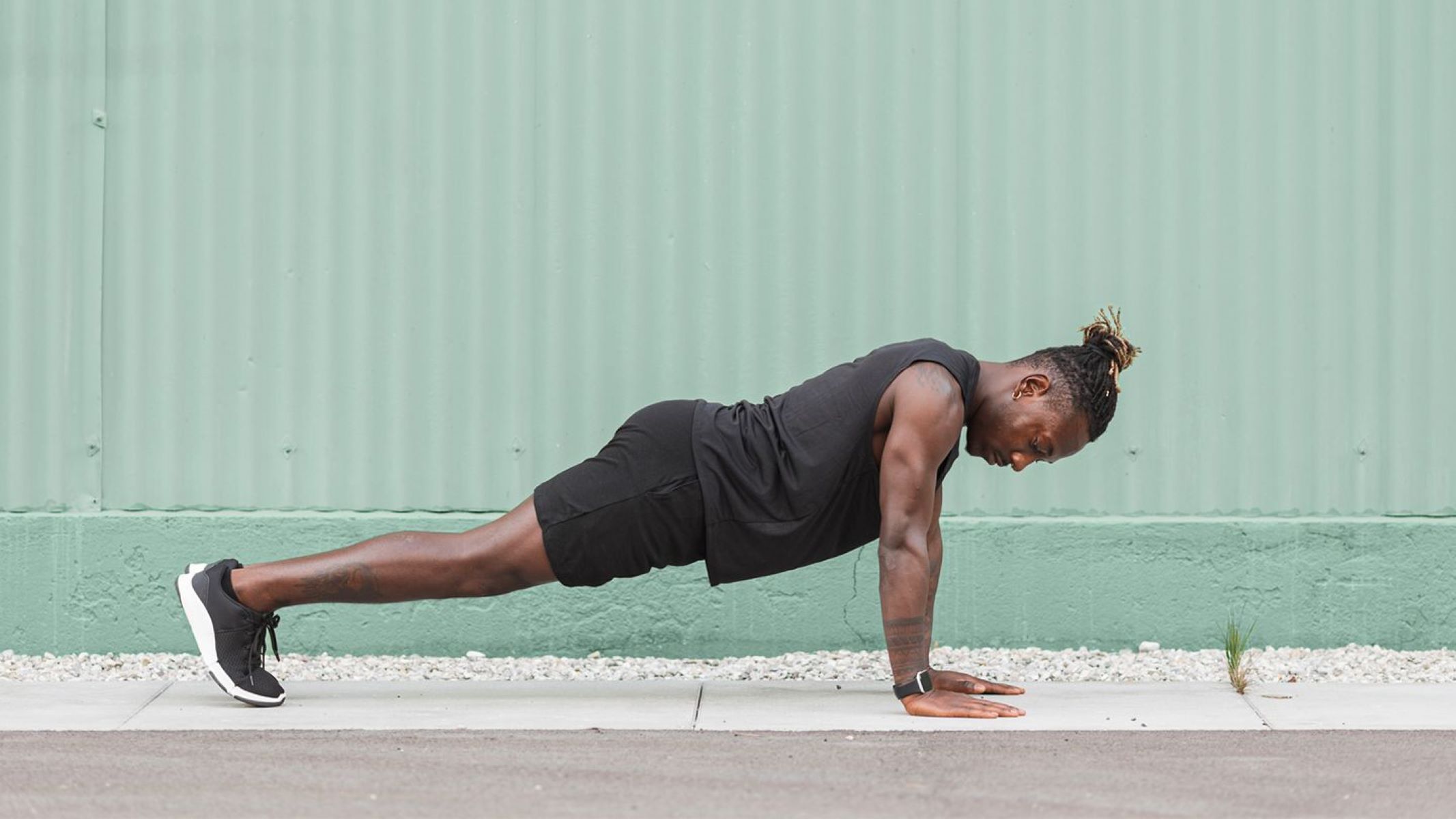

Featured
How To Build Endurance Without Running
Modified: January 22, 2024
Discover effective ways to improve your endurance without running. Check out our featured tips and techniques to build stamina and boost your fitness levels.
Introduction
Building endurance is crucial for improving athletic performance, increasing stamina, and enhancing overall fitness levels. While running is a popular choice for developing endurance, it may not be suitable for everyone. Whether you have joint pain, dislike running, or simply want to switch up your exercise routine, there are plenty of alternative activities that can help you build endurance without running.
Endurance is the ability to sustain physical activity for an extended period of time. It is essential for athletes and fitness enthusiasts who participate in activities such as long-distance running, cycling, swimming, and team sports. By increasing your endurance, you can go harder and longer, pushing your limits and achieving better results.
The good news is that there are numerous activities that can help you improve your endurance without the need to lace up your running shoes. These alternatives not only challenge your cardiovascular system but also engage different muscle groups, providing a well-rounded workout.
In this article, we will explore 10 different activities that can help you build endurance without running. Whether you prefer low-impact exercises or high-intensity workouts, there is an option for everyone.
So, let’s dive in and discover the exciting alternatives to running that can boost your endurance and take your fitness journey to new heights!
Importance of Endurance
Endurance is not only important for athletes but also for individuals seeking to improve their overall fitness and well-being. Here are some key reasons why building endurance is crucial:
- Enhanced cardiovascular health: Endurance exercises such as running, cycling, and swimming improve heart and lung function, reducing the risk of heart disease and improving overall cardiovascular health.
- Increased stamina: Building endurance allows you to perform physical activities for longer durations without feeling fatigued. This is particularly beneficial for athletes participating in sports that require prolonged effort, such as soccer, basketball, or tennis.
- Weight management: Endurance exercises help burn calories, assisting in weight loss and weight maintenance. The longer and more intense the workout, the greater the calorie burn.
- Mental resilience: Endurance training not only strengthens the body but also builds mental resilience. Pushing your limits and pushing through fatigue can help improve mental toughness, discipline, and determination.
- Injury prevention: By building endurance, you strengthen muscles, bones, and joints, reducing the risk of injury during physical activities. It improves stability, balance, and overall physical condition.
- Improved daily activities: Having good endurance makes everyday activities, such as climbing stairs, carrying groceries, or playing with children, easier and less tiring.
Remember, endurance is not solely about building strength and stamina in one particular activity or sport. It encompasses overall physical fitness and the ability to perform various activities without exhaustion. So, whether you are an athlete, a fitness enthusiast, or someone looking to lead a healthier and more active lifestyle, building endurance is essential.
Alternatives to Running for Building Endurance
If you’re not a fan of running or looking to diversify your workout routine, there are plenty of other activities that can help you build endurance. Let’s explore some of these effective alternatives:
- Cycling: Whether it’s indoor cycling classes or outdoor biking, cycling is a fantastic way to improve endurance. It not only engages your lower body muscles but also provides a low-impact workout that is gentle on your joints.
- Swimming: Swimming is a full-body workout that challenges your cardiovascular system and builds endurance. The resistance of the water makes swimming a great option for people of all fitness levels.
- Rowing: Rowing is a total-body exercise that targets your arms, legs, and core. It offers a low-impact and high-intensity workout, perfect for building endurance and increasing strength.
- High-Intensity Interval Training (HIIT): HIIT workouts involve short bursts of intense exercise followed by brief recovery periods. This type of training not only improves cardiovascular endurance but also helps burn calories and build strength.
- Jumping Rope: Jumping rope is a simple yet effective way to boost endurance. It is a high-impact exercise that engages multiple muscle groups and improves coordination.
- Cardio Dance Classes: Dancing is not only fun but also a great way to improve endurance. Joining cardio dance classes like Zumba or dance-based fitness programs can help you build stamina while grooving to your favorite tunes.
- Stair Climbing: Climbing stairs is an excellent way to challenge your cardiovascular system and build leg strength. Incorporate stair climbing into your workout routine or opt for using a stair climber machine at the gym.
- HIIT Workouts with Bodyweight Exercises: Combine bodyweight exercises like squats, lunges, push-ups, and burpees into a high-intensity circuit. This will not only improve endurance but also strengthen your muscles.
- Circuit Training: Circuit training involves completing a series of exercises with minimal rest in between. It targets different muscle groups and keeps your heart rate up for an extended period, improving cardiovascular endurance.
- Elliptical Training: The elliptical machine provides a low-impact, full-body workout that mimics running without the joint stress. It is a great option for people who want to build endurance without pounding the pavement.
These alternatives to running offer a diverse range of exercises that can elevate your endurance levels while keeping workouts engaging and enjoyable. Incorporate a variety of these activities into your weekly routine to challenge your body, prevent plateaus, and achieve optimal results.
Cycling
Cycling is an excellent alternative to running for building endurance. Whether you choose to hop on a stationary bike or hit the trails outdoors, cycling offers numerous benefits for your cardiovascular health and overall fitness.
One of the key advantages of cycling is that it is a low-impact exercise, meaning it puts less stress on your joints compared to activities like running. This makes it a great option for individuals with joint pain or those who are recovering from injuries.
When cycling, the continuous pedaling motion engages large muscle groups in the legs, including the quadriceps, hamstrings, and calves. This repetitive motion helps build muscular endurance and improves overall leg strength. In addition, the core and upper body also get engaged to maintain stability and balance.
Whether you choose to ride your bicycle outdoors or opt for stationary cycling classes at the gym, there are various ways to incorporate cycling into your endurance training. Here are a few suggestions:
- Interval Training: Alternate between periods of high-intensity cycling and recovery periods of slower, easier pedaling. This type of training helps improve cardiovascular fitness and build endurance.
- Hill Training: Find hilly routes or adjust the resistance on your stationary bike to simulate uphill climbs. This challenges your muscles and cardiovascular system, improving endurance and strength.
- Long-Distance Rides: Plan longer rides that challenge your stamina and endurance. Gradually increase the distance and duration of your rides to improve your cardiovascular fitness and endurance capacity.
- Group Cycling Classes: Join a group cycling class and follow the instructor’s guidance for a structured and motivating workout. The camaraderie and energetic atmosphere can push you to work harder and increase your endurance.
- Outdoor Adventure: Explore different terrains and trails while cycling outdoors. The variety in terrain engages different muscles and keeps your workouts exciting and challenging.
Cycling not only helps you build endurance but also provides a great cardiovascular workout, improves lung capacity, and supports weight loss. It is a versatile activity that can be adjusted to your fitness level, making it suitable for beginners and experienced athletes alike.
Remember to wear appropriate safety gear, such as a helmet, when cycling outdoors, and always follow local traffic laws and regulations.
Swimming
Swimming is a fantastic alternative to running when it comes to building endurance. Not only does it provide a full-body workout, but it also offers the benefits of low-impact exercise, making it suitable for people of all fitness levels.
Swimming engages all major muscle groups in the body, including the arms, legs, back, core, and shoulders. The resistance of the water provides a challenging workout, helping to build muscular endurance while improving cardiovascular fitness.
One of the unique advantages of swimming is that it is a non-weight bearing exercise, which means it places less stress on your joints compared to activities like running or jumping. This makes it an excellent option for individuals with joint issues or those recovering from injuries.
In addition to improving endurance, swimming also enhances lung capacity and strengthens the heart. The rhythmic breathing patterns required in swimming help increase lung efficiency over time.
Here are some ways you can incorporate swimming into your endurance training routine:
- Lap swimming: Swim laps in a pool, focusing on maintaining a steady and consistent pace. Gradually increase the duration or distance of your swims to challenge your endurance.
- Interval training: Alternate between periods of swimming at a faster, more intense pace and slower recovery periods. This helps improve cardiovascular fitness and builds endurance.
- Stroke variety: Practice different swimming strokes (freestyle, backstroke, breaststroke, and butterfly) to engage different muscle groups and add variety to your workouts.
- Water workouts: Join water aerobics or aqua fitness classes that incorporate swimming movements with resistance exercises in the water. These classes offer a fun and effective way to build endurance while minimizing the impact on your joints.
- Open water swimming: If you’re comfortable in open water, consider swimming in natural bodies of water. Experiencing different environments and conditions challenges your endurance and provides a refreshing change from pool swimming.
Swimming not only improves cardiovascular fitness and endurance but also provides a full-body workout that builds strength and flexibility. It is a refreshing and versatile activity that allows you to work at your own pace and level of intensity.
Remember to practice proper swimming techniques, warm up properly before each swim, and gradually increase the intensity and duration of your swimming sessions to avoid overexertion and improve your endurance steadily.
Rowing
Rowing is an excellent alternative to running for building endurance and strength. This full-body exercise engages multiple muscle groups simultaneously while providing a low-impact workout.
When you row, you use your legs, core, and upper body muscles in a coordinated motion. This includes the quadriceps, hamstrings, glutes, back muscles, shoulders, and arms. The continuous pulling and pushing motion of rowing challenges your cardiovascular system, improving both endurance and stamina.
One of the advantages of rowing is that it allows you to control the intensity of your workout. By adjusting the resistance on the rowing machine, you can make your workout more challenging and target specific muscle groups. This flexibility makes rowing suitable for individuals of all fitness levels.
Here are some ways you can incorporate rowing into your endurance training:
- Interval Training: Alternate between high-intensity rowing and brief periods of active rest. For example, row for 1 minute at a fast pace, followed by 30 seconds of slower rowing or rest. Repeat this cycle for a set duration and gradually increase the intensity or duration of your high-intensity intervals.
- Pyramid Workouts: Start with a short warm-up row, then gradually increase the duration or intensity of your rowing in set increments (e.g., 1 minute, 2 minutes, 3 minutes, and then back down). This workout structure helps challenge your endurance and builds mental resilience.
- Long Steady-State Rows: Row at a moderate intensity for an extended period, such as 30 minutes to an hour. This type of workout helps build endurance and trains your body to sustain effort over time.
- Rowing Classes: Consider joining group rowing classes at your local gym or rowing club. These instructor-led sessions provide structure, motivation, and a sense of community as you work together to improve your endurance and rowing technique.
Rowing not only improves cardiovascular endurance but also increases muscular strength and power. It is a low-impact exercise that puts minimal stress on your joints, making it a suitable option for individuals with joint issues or those looking for an alternative to high-impact activities like running.
Remember to maintain proper rowing technique, engage your core throughout the movement, and focus on a smooth, fluid motion. Gradually increase the duration and intensity of your rowing sessions to challenge your endurance and achieve optimal results.
High-Intensity Interval Training (HIIT)
High-Intensity Interval Training (HIIT) is a popular and effective way to build endurance without relying on traditional long-distance running. This workout method involves alternating between short bursts of intense exercise and brief periods of rest or active recovery.
HIIT workouts are known for their efficiency and effectiveness in improving cardiovascular fitness and burning calories. The intense intervals push your body to its limits, challenging your endurance and stamina. The short recovery periods allow you to catch your breath and prepare for the next round of high-intensity exercise.
One of the significant advantages of HIIT is that you can customize your workouts to your fitness level and preferences. You can choose different exercises, such as bodyweight exercises, plyometrics, or cardiovascular activities like jumping jacks or burpees, to incorporate into your HIIT routine.
Here’s how to incorporate HIIT into your endurance training:
- Choose your exercises: Select a combination of exercises that target different muscle groups and elevate your heart rate. Examples include jumping jacks, high knees, mountain climbers, squat jumps, and bicycle crunches.
- Warm-up: Start with a dynamic warm-up to prepare your body for the workout. Engage in light cardio exercises like jogging in place, arm circles, and leg swings to warm up your muscles.
- Work-to-Rest Ratio: Determine the duration of your high-intensity intervals and the length of your recovery periods. Beginners may start with a 1:2 work-to-rest ratio (e.g., 30 seconds of exercise followed by 1 minute of active recovery), while more advanced individuals can decrease the rest periods or increase the duration of the intense intervals.
- Repeat and progress: Perform a series of high-intensity intervals followed by recovery periods. Start with shorter workouts and gradually increase the number of intervals or the total duration of the workout as your endurance improves.
- Cool down and stretch: Finish your HIIT session with a cool-down to gradually lower your heart rate. Follow it up with static stretches to improve flexibility and prevent muscle soreness.
HIIT workouts are time-efficient and can be done anywhere, making them a versatile option for those with busy schedules. They not only improve endurance but also boost metabolism and may continue to burn calories even after your workout is complete.
Remember to listen to your body and work at an intensity that challenges you without sacrificing proper form. Start with shorter intervals and gradually progress as your fitness level improves. Consulting a fitness professional is recommended if you are new to HIIT or have any underlying health conditions.
Jumping Rope
Jumping rope is a fun and effective alternative to running for building endurance. It is a high-impact exercise that engages multiple muscle groups and gets your heart rate up, making it an excellent choice for boosting cardiovascular fitness.
Jumping rope not only improves endurance but also enhances coordination, agility, and overall cardiovascular health. This simple yet versatile exercise can be easily incorporated into your workout routine, either as a standalone activity or as part of a circuit training session.
Here’s how to incorporate jumping rope into your endurance training:
- Start with a warm-up: Before you start jumping rope, perform a dynamic warm-up to prepare your body. This can include exercises like arm swings, leg swings, and jumping jacks.
- Choose the right jump rope: Select a suitable jump rope that is the ideal length for your height. A properly fitted rope ensures smooth rotations and a comfortable jumping experience.
- Beginner’s technique: If you’re new to jumping rope, start with basic jumps. Stand with your feet shoulder-width apart, hold the handles at waist level, and jump off the balls of your feet, keeping your knees slightly bent.
- Vary your jumps: As you progress, experiment with different jump variations to increase the intensity and challenge your endurance. These can include single-leg jumps, double unders, crossover jumps, or alternating foot jumps.
- Set a time or repetition goal: Define a specific duration or number of jumps for your workout. For example, you could aim for 1 minute of continuous jumping or a specific number of jumps within a set time frame.
- Interval training: Alternate between periods of fast-paced jumping and short rest periods or active recovery exercises. This interval format helps improve endurance, burn calories, and build strength.
- Incorporate into circuit training: Jumping rope can be a great addition to a circuit training workout. Include it as one of the stations in your circuit, performing a set number of jumps before moving on to the next exercise.
Jumping rope provides an effective cardiovascular workout while requiring minimal equipment and space. It can be done anywhere, making it a convenient option for those who prefer to exercise at home or in limited spaces.
Remember to wear proper footwear to absorb impact, jump on a cushioned surface if possible, and start slowly if you’re new to jumping rope. Gradually increase the intensity and duration of your sessions as your endurance improves.
Jumping rope not only builds endurance but also improves coordination, agility, and strengthens the lower body. It’s a fun and versatile exercise that can be enjoyed by people of all fitness levels.
Cardio Dance Classes
If you’re looking for a fun and energetic way to build endurance without running, cardio dance classes are a fantastic option. These classes combine dance moves with cardiovascular exercises, offering a high-energy workout that improves endurance and coordination.
Cardio dance classes come in various styles, such as Zumba, dance fitness, hip-hop, or even Latin dance-inspired workouts. These classes typically feature upbeat music, choreographed routines, and dynamic movements that engage your entire body.
Here’s why cardio dance classes are an excellent choice for building endurance:
- Cardiovascular workout: The continuous movements, jumps, and turns in a cardio dance class get your heart rate up and promote cardiovascular fitness. The combination of aerobic exercise and dance routines helps improve endurance over time.
- Full-body workout: Dancing requires coordination and engages multiple muscle groups simultaneously. You’ll be using your legs, arms, core, and even your brain as you follow the choreography. This results in a comprehensive workout that builds endurance and strengthens your entire body.
- Improved coordination and agility: Following dance routines helps improve your coordination, balance, and agility. As you become more proficient in the dance moves, your overall body control and agility will improve, enhancing your endurance in various physical activities.
- Fun and motivating: Dancing to upbeat music in a group setting can be incredibly enjoyable and motivating. The energetic atmosphere and supportive community in cardio dance classes can inspire you to push your limits and keep coming back for more.
To get the most out of cardio dance classes, consider the following:
- Consistency: Attend classes regularly to build endurance gradually. Aim for at least two to three sessions per week to see improvements over time.
- Challenge yourself: Take on more advanced routines or add extra intensity to your movements as you become more comfortable. Pushing yourself out of your comfort zone helps improve stamina and endurance.
- Listen to your body: Pay attention to your fitness level and take breaks as needed during high-intensity sections. Over time, your endurance will increase, and you’ll be able to sustain the intensity for longer durations.
- Have fun: Remember to enjoy the music, the movements, and the energy of the class. The more engaged and passionate you are about the workout, the more motivated you’ll be to challenge yourself and improve your endurance.
Cardio dance classes offer a unique and enjoyable way to build endurance. So put on your dancing shoes, hit the dance floor, and get ready to shimmy, shake, and sweat your way to improved stamina and cardiovascular fitness!
Stair Climbing
Stair climbing is a challenging yet highly effective activity for building endurance. It is a weight-bearing exercise that targets multiple muscle groups and elevates your heart rate, making it an excellent alternative to running.
Stair climbing engages large muscles in your lower body, such as your quadriceps, hamstrings, glutes, and calves. It also activates your core muscles as you stabilize your body while ascending and descending stairs.
Here are a few ways to incorporate stair climbing into your endurance training:
- Outdoor stairs: Find a nearby set of stairs, whether it’s at a park, stadium, or the stairs in a tall building. Start by climbing up and down the stairs at a moderate pace. As your endurance improves, challenge yourself by increasing the number of repetitions or the speed at which you climb.
- Stair machine: If outdoor stairs aren’t accessible to you, consider using a stair climber machine at the gym. These machines simulate the movement of climbing stairs and allow you to adjust the intensity and resistance.
- Interval training: Alternate between periods of higher intensity stair climbing and lower intensity periods of active recovery. For example, climb the stairs quickly for 1 minute, followed by a slower climb or walk for 30 seconds. Repeat this cycle for a set duration to build endurance and increase cardiovascular fitness.
- Stair sprints: For a more intense workout, perform stair sprints. Sprint up the stairs as fast as you can, then walk or jog back down for recovery. Repeat for several sets, gradually increasing the number of sprints as your endurance improves.
- Stair circuit: Create a circuit by incorporating other exercises at each landing or step, such as lunges, squats, or push-ups. This combination of stair climbing and strength exercises adds variety and challenges your endurance in different ways.
Stair climbing not only improves cardiovascular endurance but also helps strengthen your lower body muscles and increases bone density. It is a weight-bearing exercise, which is beneficial for maintaining healthy bones, especially for individuals at risk of osteoporosis.
Remember to maintain proper posture, engage your core, and use the full range of motion as you climb the stairs. Start with a comfortable pace and gradually increase the intensity and duration of your stair climbing sessions as your endurance improves.
Whether you choose outdoor stairs or a staircase at the gym, stair climbing provides a challenging and effective way to build endurance, burn calories, and strengthen your lower body.
HIIT Workouts with Bodyweight Exercises
High-Intensity Interval Training (HIIT) workouts that incorporate bodyweight exercises are a fantastic way to build endurance without the need for running. These workouts combine intense bursts of exercise with short periods of rest or active recovery, providing an excellent cardiovascular challenge.
One of the great advantages of HIIT workouts with bodyweight exercises is that they can be done anywhere, requiring minimal to no equipment. This makes them accessible for individuals of all fitness levels, from beginners to advanced athletes.
Here’s how to structure your HIIT workout with bodyweight exercises to improve endurance:
- Choose your exercises: Select a variety of bodyweight exercises that target different muscle groups and elevate your heart rate. Examples include push-ups, squats, lunges, burpees, mountain climbers, and plank jacks.
- Establish work-to-rest ratio: Determine the duration of your high-intensity intervals and the length of your rest periods. A common ratio for beginners is 1:2 (e.g., 30 seconds of exercise followed by 1 minute of rest). As you progress, decrease the rest periods or increase the duration of the intense intervals.
- Design your workout: Create a circuit of bodyweight exercises, performing each exercise for the specified duration, followed by a short rest period. Repeat the circuit for a designated number of rounds or a set duration. This continuous cycle challenges your endurance and boosts cardiovascular fitness.
- Progression: Gradually increase the intensity of your workouts as your endurance improves. You can achieve this by adding more rounds to your circuit, increasing the duration of each exercise, or incorporating more challenging variations of the exercises.
- Vary your exercises: Switch up the exercises in each workout to keep it interesting and challenge your body in different ways. This variation also prevents plateaus and ensures that you are engaging various muscle groups.
Bodyweight HIIT workouts provide numerous benefits beyond building endurance. They help burn calories, improve strength, and require minimal time. Additionally, they can be modified to suit your fitness level and goals.
Remember to warm up before each HIIT workout to prepare your body for the intensity. Perform a combination of dynamic stretches and light cardio exercises to increase blood flow and loosen up your muscles. After each session, cool down and stretch to aid in muscle recovery and prevent post-workout soreness.
Whether you’re in the comfort of your own home, at the park, or in a gym, bodyweight HIIT workouts are convenient, versatile, and highly effective for boosting endurance and overall fitness.
Circuit Training
Circuit training is a dynamic and efficient way to build endurance without relying on running. This form of workout involves moving quickly from one exercise to another, targeting different muscle groups and keeping your heart rate elevated throughout the session.
The flexibility and versatility of circuit training make it an excellent option for individuals of all fitness levels. It allows you to incorporate a combination of cardiovascular exercises, strength training, and bodyweight exercises, providing a comprehensive and challenging workout.
Here’s how to set up your circuit training session for endurance improvement:
- Choose your exercises: Select a variety of exercises that target different muscle groups and incorporate cardiovascular movements. Examples include jumping jacks, squat jumps, push-ups, burpees, kettlebell swings, mountain climbers, and bicycle crunches.
- Set up your circuit: Determine the number of exercises you want to include in your circuit and allocate a specific time for each exercise. Aim for 30 seconds to 1 minute per exercise to challenge your endurance. Plan a layout where you can seamlessly move from one exercise to the next with minimal rest.
- Perform the circuit: Start with a brief warm-up, such as light cardio exercises or dynamic stretches. Then, move through each exercise in the circuit, performing one after the other with minimal rest in between. Complete the circuit for a designated number of rounds, aiming to maintain a challenging but sustainable pace throughout.
- Progression: As your endurance improves, increase the number of rounds or the intensity of each exercise. You can also incorporate more challenging variations or increase the time spent on each exercise.
Circuit training not only improves cardiovascular endurance but also enhances muscular strength, power, and overall fitness. By alternating between different exercises, you engage various muscle groups, providing a well-rounded workout.
Additionally, circuit training offers flexibility in terms of time commitment, as it can be tailored to fit your schedule. Whether you have 20 minutes or an hour, you can adjust the circuit to match the time available while still reaping the benefits of endurance training.
Remember to maintain proper form and technique for each exercise and listen to your body. If needed, modify exercises to suit your fitness level and gradually increase the intensity as your endurance improves.
Circuit training provides a challenging and time-efficient way to build endurance and improve overall fitness. Embrace the variety and enjoy the benefits of this dynamic and effective training method.
Elliptical Training
Elliptical training is a low-impact exercise that can be an excellent alternative to running for building endurance. The elliptical machine provides a smooth and fluid motion that mimics the natural movement of walking, jogging, or stair climbing, without the impact on your joints.
Using an elliptical machine engages both your upper and lower body, targeting major muscle groups such as your quadriceps, hamstrings, glutes, and arms. This full-body workout challenges your cardiovascular system and helps improve endurance.
Here’s how to incorporate elliptical training into your endurance routine:
- Warm-up: Start with a 5-10 minute warm-up on the elliptical machine at a comfortable and moderate pace. This helps prepare your muscles for the workout and gradually increases your heart rate.
- Interval Training: Alternate between periods of higher intensity and lower intensity or active recovery on the elliptical. Increase the speed, resistance, or incline to challenge yourself during the intense intervals, then decrease the intensity during the recovery periods. This interval training method helps improve endurance and cardiovascular fitness.
- Hill Simulation: Utilize the incline feature on the elliptical machine to simulate climbing hills. Adjust the resistance and incline levels to mimic uphill climbs, challenging your muscles and further improving your endurance.
- Resistance Training: Increase the resistance level on the elliptical machine to make your workout more challenging. This puts additional resistance on your muscles, helping to build strength and stamina.
- Long-Distance Sessions: Extend the duration of your elliptical workout to challenge your endurance. Gradually increase the length of your sessions, aiming for longer distances or time increments as your fitness level improves.
Elliptical training allows you to control and adjust the resistance, speed, and intensity of your workout, making it suitable for individuals of all fitness levels. It offers a low-impact option that is gentle on the joints, making it particularly beneficial for individuals recovering from injuries or those with joint issues.
Remember to maintain proper posture, engage your core muscles, and use both your arms and legs to get a full-body workout. Also, ensure that you choose an appropriate resistance level and speed that challenge you without straining your muscles or compromising your form.
Incorporating elliptical training into your endurance routine provides an effective cardiovascular workout, improves lower body strength, and helps build endurance. So, hop on the elliptical machine and elevate your fitness to new heights!
Conclusion
Building endurance without running is absolutely possible, and there are plenty of alternatives available that can help you achieve your fitness goals. Choosing activities that challenge your cardiovascular system, engage different muscle groups, and provide a variety of movements is key to enhancing endurance.
We explored ten different alternatives to running for building endurance. Cycling, swimming, rowing, high-intensity interval training (HIIT), jumping rope, cardio dance classes, stair climbing, HIIT workouts with bodyweight exercises, circuit training, and elliptical training all provide unique benefits and can be tailored to your fitness level and preferences.
Each of these activities offers an opportunity to improve cardiovascular fitness, increase stamina, and enhance overall endurance. Whether you’re a beginner or an experienced athlete, there’s a suitable option for you.
Remember to incorporate warm-up and cool-down periods into your workouts, listen to your body, and gradually increase the intensity and duration of your training sessions. Consistency is key, so aim to incorporate these activities into your routine on a regular basis to see improvements in your endurance over time.
So, lace up your cycling shoes, dive into the pool, grab those oars, or dance to the beat – the options are endless. Embrace the diversity of these alternatives to running and discover the joy of building endurance in a way that suits your fitness preferences and goals. Stay consistent, enjoy the journey, and watch your endurance soar!









